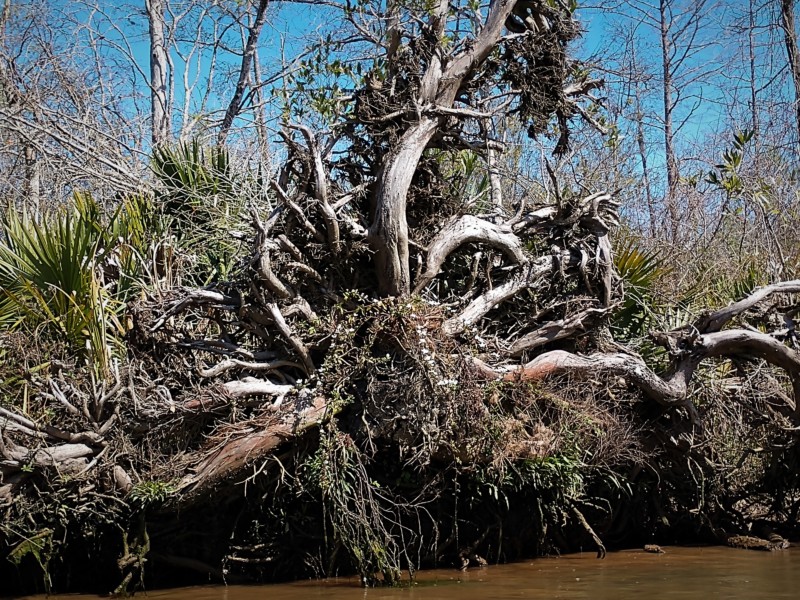by ANNE BRALY
MOSS POINT, Miss. – “Y’all, see those wood ducks over there?” asks Captain Benny McCoy in his telltale Southern dialect as he points to a female duck swimming in a spot across the Pascagoula River, the largest by volume in the lower-48 states. “She don’t land. She just flies right into her nest. I wonder why she don’t break her neck.”
McCoy didn’t go to college, but he knows as much about the flora and fauna around the Pascagoula River as most any scientist. He worked on a highway construction crew as a young man, then took a job in a shipyard in Pascagoula, Miss. But about 20 years ago, he returned to the river — his playground as a boy — and began offering tours of the river on a pontoon boat specially fitted with padded bench-style seats for comfort on the water and a roof overhead for protection from the sun.
McCoy Swamp and River Tours set sail from a dock on the riverbank at the Pascagoula River Audubon Center in Moss Point, Miss.
Pascagoula’s source is at the confluence of the Leaf and Chicasawhay rivers in Mississippi’s DeSoto National Forest, where it then meanders about 80 miles to the Gulf of Mexico. More than 70,000 acres of land surrounding the river have been preserved for the public. The tour lasts around two hours and takes you into another time and place through three distinct habitats: the river with its brackish water; the marsh with its tall bull grasses growing from its brackish water; and finally the freshwater swamp that comes alive in spring and summer with colorful backberry vines, blooming iris, marsh mallows, swamp mallows and spiders lilies.
The river is like a chameleon, changing its flow from choppy in the river to smooth in the marsh. In the swamp, the current barely creeps alongside stands of Yaupon holly, bay dwarf palmetto palms and bay trees whose leaves help flavor the culinary bounty of the bayou. As you progress into the different habitats, the water’s color shifts from blue to brown to black. Earthy smells speak to your soul and heighten your senses along the way through a series of sights and sounds, including, white-tailed deer, alligators and wild hogs.
“Them hogs, they’ll eat about anything,” McCoy says as he guides the boat through the quiet, swampy waters. “That’s why there’s no snakes here anymore.”
Maybe no snakes, but the pelicans and other birds are back after having been decimated by DDT back in the 1940s and ‘50s. Seeing a mother bald eagle feeding her young in a nest high up in a pine tree or an osprey fishing for a midday meal is a common sight now.
The bayous and other bodies of water are once again teeming with marine life.
“These estuaries are very important for us,” McCoy says, a sparkle in his eyes as he talks about his river. “Especially if you like seafood. This is where baby crabs and shrimp is being raised — and the fish that like to eat them, too.”
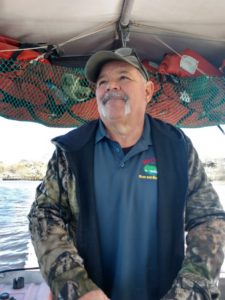
The Singing River
It’s a mysterious thing, this river. Locals know it as The Singing River. According to legend, the Pascagoula Indian tribe lived and thrived along the river, but walked into the river to their deaths, singing as they went, rather than surrendering to the invading Biloxi Indians.
But the river holds even more questions as the tour continues. You’ll see a white cross in the grasslands of one bayou marking the spot where two fishermen died. No one knows how or why, McCoy says.
Like Huck Finn, McCoy lived and breathed the river as a boy and remembers an old man who lived alone on an river island. “He’d come into town about once a month, and I’ve asked a lot of people whatever happened to him, and no one knows.”
And it’s said you can hear unexplained sounds — even the song of the Pascagoula Indians — as you travel down the river. “I’ve heard the strangest sounds — like somebody moaning,” McCoy says. “I ain’t never heard a sound like that. And I ain’t the only one.”
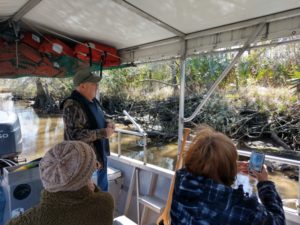

After the cruise
Though there is a beautiful beach stretching 26 miles along the Mississippi coast between Biloxi and Pass Christian, Anna Roy, public/media relations manager for Coastal Mississippi, says the area not only promotes itself as a beach destination, but also as an area that offers equally as much to do onshore. When the cruise is over, visit the Mardi Gras museum in its new downtown location; the Maritime & Seafood Museum on the banks of the Biloxi Bay and learn about the importance of the seafood and boating industry along the Gulf Coast; or the Ohr-O’Keefe Museum on Beach Boulevard with its collection of the pottery of George Ohr, the “Mad Potter of Biloxi” and the architecture of famed architect Frank Gehry.
And don’t forget the food. Of note is White Pillars where award-winning chef and James Beard semi-finalist Austin Sumrall turns local foods into memorable meals. At Harrah’s Magnolia House, Chef Kelly English, with two restaurants in Memphis, brings flavors of the bayou to the table; and at Le Bakery, Sue Nguyen-Torjusen makes mouthwatering pastries and other treats.
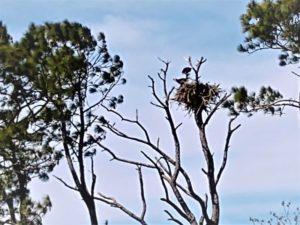

Where to lay your head
The main drag through Biloxi is lined with casinos, such as Hard Rock and Harrah’s, both with overnight accommodations overlooking the gulf. There’s also almost every chain motel you can think of. But venture just a bit farther along the Mississippi Gulf Coast and experience the grace and charm for which small Southern towns are known, such as Long Beach, Pass Christian and Bay St. Louis.
Ocean Springs, a charming storybook town, is another that exudes character and is in a central location between Biloxi and Pascagoula. It’s ancient live oaks with Spanish moss dripping like tendrils, line the streets. Colorful shops; Cafes; and award-winning restaurants, such as Maison de Lu and Vestige, the latter owned by James Beard finalist Alex Perry, can be found on Washington Street, the main drag through the small downtown.There are no big chain motels in town, only lovely inns, such as The Roost, a boutique hotel; and The Inn at Ocean Springs, a lovely bed-and-breakfast.
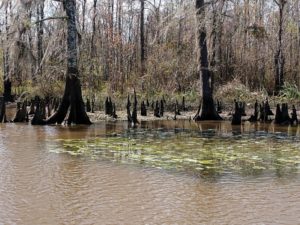

By plane, train or automobile
Getting to the Biloxi area and its surroundings is easy. There are several direct flights into Gulfport, Miss., — just a short drive away — from Atlanta; Orlando; Dallas; Austin, Texas; Charlotte, N.C.; and Fort Myers. Fla. And now, a new one has been added — Nashville.
Or, you can take a train into New Orleans, rent a car and make a leisurely, lovely drive into Biloxi, which will only take about an hour. By 2023, Amtrak will offer a train route from Mobile, Ala., to New Orleans, with stops along the way, including Biloxi.
If you choose to drive, the road is easy. From the north, I-65 takes you to Mobile, about an hour from the Mississippi line. From the east or west, hop on I-10 and it will take you straight into town.
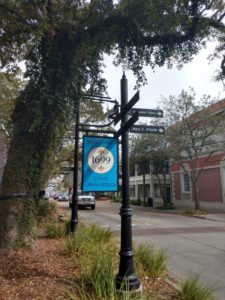

To schedule a tour
Tours on the Pascagoula River run daily, weather permitting. For a reservation, log onto mccoyrivertours.com or call (228) 219-4583. Tours are $30 for adults and $22 for children under the age of 12.


